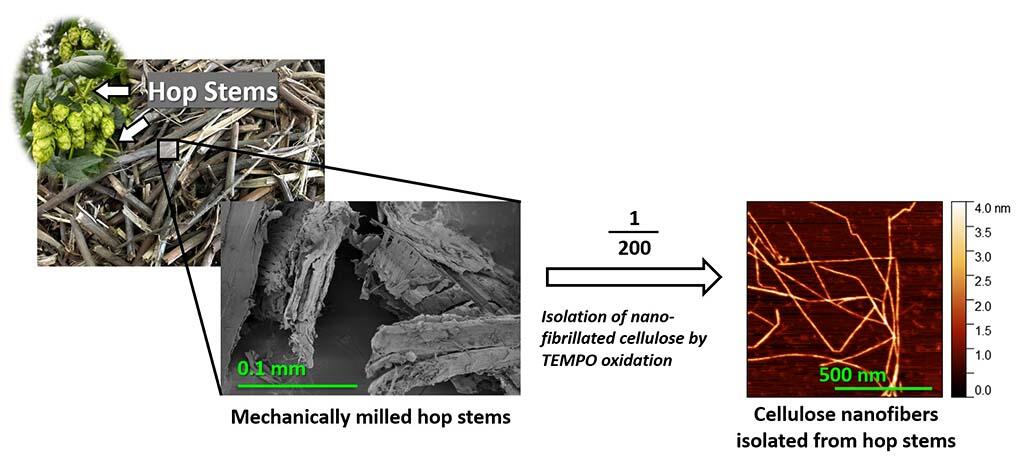One of the essential ingredients of beer is hop, which imparts the signature bitter taste and aroma. This plant grows on long stems of over 5 meters tall. After the cones of the plant have been harvested, remaining stems are burned or landfilled to be discarded as agricultural waste. The research group of Associate Professor Izuru Kawamura of the Graduate School of Engineering Science and Noriko Kanai of the Doctoral Program of the Graduate School of Engineering Science (Gakushin DC1) at Yokohama National University and, as well as Manager Kosuke Nishimura of Tono Mirai Zukuri College, successfully isolated TEMPO-oxidized cellulose nanofibers from hop stems, which had been discarded as industrial waste. They also revealed the structure of cellulose nanofibers derived from hop stems. The group achieved upcycling to extract a substance with a high environmental value from hop stem that had previously been discarded. This not only shows the potential of hop stem as a new resource of cellulose nanofibers but also highlights its contribution to the SDGs. These findings were published in ACS Agricultural Science & Technology (https://pubs.acs.org/doi/10.1021/acsagscitech.1c00041).
Tono City in Iwate Prefecture has been known as Japan's primary hop-producing area since it signed a hop cultivation contract with Kirin Beer in 1963. Hop is now one of the cities' most important agricultural products. Hop cone production in Japan is about 200 tons, and about 95% of its production area is concentrated in the Tohoku region. However, hop production in Japan has declined owing to factors such as generation of a large amount of agricultural waste, an aging population, a shortage of hop farmers, and delay in the introduction of advanced technology.
On the other hand, a town development that makes maximum use of hop is being carried out in Tono City in collaboration with industry and government, and a project to foster a new beer culture and disseminate it to the world is underway with the concept "From hop village to beer village." Tono Mirai Zukuri College has continued to explore the utilization of hop stems as a resource that creates new value. Thus, it proposed developing cellulose nanofibers from hop stems to achieve SDGs, starting with the discussion at "Innovation Summer College," a program for exploring regional issues and demonstrating experiments by regional high school students, university students, and international students held in August 2020. Based on this idea, the present study was conducted by the group of Associate Professor Kawamura who had previously isolated cellulose nanofibers from coffee grounds.
The research group aimed to upcycle (efforts beyond the 3R to create new substances with a high environmental value from waste) by producing cellulose nanofibers (CNF) with a high environmental value from hop stems, which had been discarded as agro-industrial waste, provided by Tono City in Iwate Prefecture. They revealed that hop stems contain more than 40% cellulose by dry weight, and successfully isolated CNF from dried particles of hop stems using the TEMPO-mediated oxidation method. Structural analysis of CNF using field-emission scanning electron microscopy, atomic force microscopy, X-ray diffraction, and solid-state nuclear magnetic resonance spectroscopy revealed uniform CNF with an average diameter of 2 nanometers obtained from two samples of hop stems, one untreated and the other pretreated to remove lignin and hemicellulose.

Credit: Yokohama National University
Furthermore, the research group showed that pretreatment almost completely removed impurities, enhancing the crystallinity of CNF. The results of both structural analysis and thermogravimetric measurement showed that the TEMPO-oxidized CNF derived from hop stems had the same structural properties and thermal stability as the TEMPO-oxidized CNF derived from wood. In addition, the cellulose content per gram of hop stems was comparable to that of wood resources, suggesting that the use of hop stems as a new raw material for CNF could establish a groundbreaking upcycle in the hop industry.
Full-scale social implementation of the use of hop stem as a raw material for CNF will require further research to investigate its new functionality and ensure high added value, in addition to the construction of a more efficient method of CNF extraction. Taking advantage of concentrated hop production in the Tohoku region, the collaboration between companies aiming to use hop-derived CNF and hop farmers is necessary to build a local circular economy. This is a successful example of the university's role in regional development, and further efforts are expected in the future.
This article has been translated by JST with permission from The Science News Ltd.(https://sci-news.co.jp/). Unauthorized reproduction of the article and photographs is prohibited.




